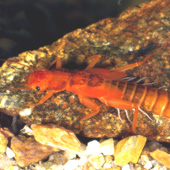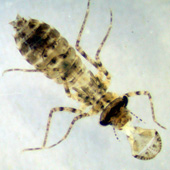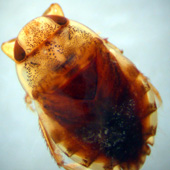|
|
Taxonomic ResolutionAfter Marshall et al. (2006)[1] Macroinvertebrates collected from 29 sites in the Condamine-Balonne River system were identified to the lowest possible taxonomic level. Species data were aggregated into genus, family and order-level data, and all four datasets were analysed. Using quantitative abundance data, interpretations from species, genus and family-level statistical analyses were similar, and patterns in ordination space were near identical.
Quick facts
There was also a high similarity between patterns identified from species and order datasets, but ordination revealed some loss of detail in the pattern at order level. Transformation of the abundance data to presence/absence (binary) data resulted in lower overall levels of similarity and loss of pattern resolution with respect to the species abundance data set.
Dendogram showing the relationships between Bray-Curtis association matrices of macroinvertebrate data from 29 study sites identified to different taxonomic levels, and with two quantification levels (log10(x+1) and presence/absence). Similarity represents the spearman rank correlation between the matrices. The results of the study indicated that little information was added by identifying taxa to species (or genus), as opposed to family, and that quantifying the abundance of taxa provided greater resolution for pattern interpretation than simply noting their presence/absence. Species richness was well represented by genus, family and order richness, so that each of these could be used as surrogates of species richness if, for example, surveying to identify diversity hot-spots. Family richness had advantages over the other taxonomic levels that underestimated species richness disproportionately more when species richness was high than when it was low, whereas family richness did not. It is suggested that sharing of common ecological responses among species within higher taxonomic units is the most plausible mechanism for the results.
Ordination plots in two dimensions (from SSH) illustrating the relationships amongst samples from the 29 study sites. The level of stress is indicated on each plot. Note that log transformations use base 10 Log(x+1) refers to the abundance datasets, whilst p/a refers to the presence/absence datasets. All plots have been Procrustes rotated to match the orientation and scale of the species abundance plot.
References
Last updated: 22 March 2013 This page should be cited as: Department of Environment, Science and Innovation, Queensland (2013) Taxonomic Resolution, WetlandInfo website, accessed 8 May 2025. Available at: https://wetlandinfo.des.qld.gov.au/wetlands/what-are-wetlands/definitions-classification/classification-systems-background/methods/taxonomic-resolution.html |

 — Department of the Environment, Tourism, Science and Innovation
— Department of the Environment, Tourism, Science and Innovation







